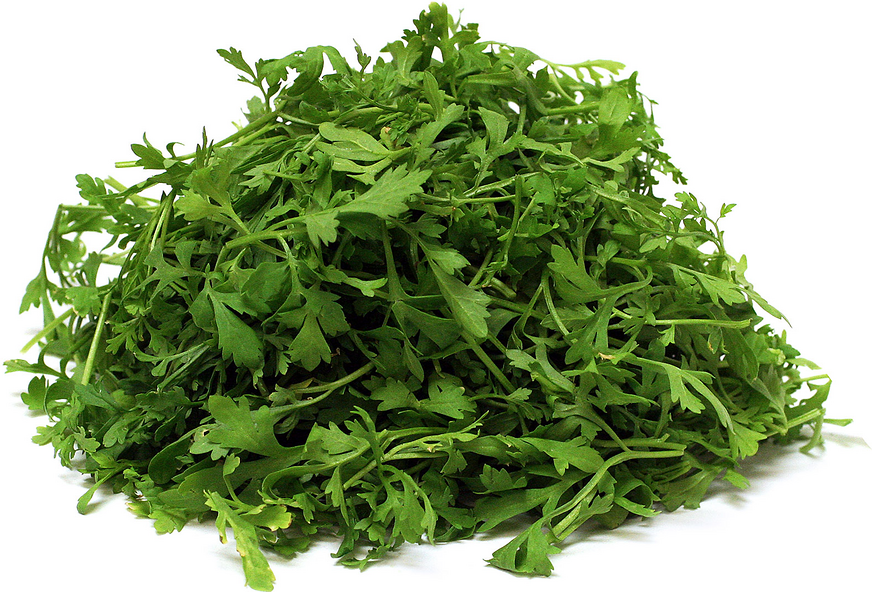


Persian Watercress
Estimated Inventory, bunch : 0
Description/Taste
Persian cress is a leafy, branched herb comprised of small leaves averaging 5 to 8 centimeters in length, attached to slender, elongated stems. The leaves are dark green, flat, and pliable with lobed, frilly to serrated edges, while the stems are green, crunchy, and semi-fibrous. Persian cress has a succulent, tender, and crisp consistency and contains a refreshing, mild, and peppery flavor with subtly sweet, tangy, and vegetal nuances. The herb also produces tiny, brown seeds utilized in culinary preparations, generally crushed and mixed with water as a pungent flavoring.
Seasons/Availability
Persian cress is available in the spring through late fall.
Current Facts
Persian cress, botanically classified as Lepidium sativum, is a mild, peppery herb belonging to the Brassicaceae family. The herbaceous annual is a type of garden cress, small and fast-growing, reaching 20 to 25 centimeters in height, and is also known as Shahi, Shawhi, Tartizak, and Persian Broadleaf cress. Persian cress is an ancient cultivar that has been utilized in Middle Eastern cuisine, especially Persian, for thousands of years. The serrated leaves have a milder, peppery flavor than Western garden cresses and are primarily incorporated fresh as a vibrant side dish or topping.
Nutritional Value
Persian cress is a good source of vitamin K for faster wound healing, vitamin A to maintain healthy organ functioning, and vitamin C to strengthen the immune system. The leaves are also a source of fiber to regulate the digestive tract, potassium to balance fluid levels within the body and contain lower amounts of magnesium, folic acid, calcium, and iron.
Applications
Persian cress has a peppery, herbal flavor well suited for fresh preparations. The leaves can be chopped and mixed into creamy dips, combined into soft cheeses, or blended into sauces, including pesto. Persian cress can also be incorporated into soups and curries, mixed into rice-based dishes, topped over omelets and frittatas, or tossed into salads. The herbal, vegetal nature of the leaves lends themselves to being blended into smoothies or stuffed into sandwiches, or the leaves can be lightly stir-fried with vegetables. Persian cress should not be extensively cooked as heat will break down the texture and flavor of the leaves. Globally, Persian cress is prominently used in Persian cuisine as a fresh flavoring. Persian cuisine is known for lightly spiced dishes, but aromatic herbs are always served as a side dish to incorporate additional flavor, texture, and sensory elements. Persian cress pairs well with eggs, seafood, poultry, spices such as caraway, cumin, and coriander, radishes, cucumbers, mango, pineapple, walnuts, feta, and herbs including dill, cilantro, spearmint, basil, and parsley. Unwashed Persian cress will keep 3 to 5 days when stored in the refrigerator either in a plastic bag or placed upright in a glass of water and covered.
Ethnic/Cultural Info
In Iran, Persian cress is cultivated on farms and in greenhouses for culinary use. The herb is favored for its vegetal, peppery flavor and is commonly used fresh. Persian cress is traditionally incorporated into sabzi khordan, roughly translating to mean “edible greens.” Sabzi khordan is essentially a plate of raw herbs and vegetables, customarily paired with feta cheese and flatbread. The flavorful dish can be served with almost any meal in Persian cuisine and acts as a salad substitute, providing fresh nuances to simply spiced meals. Sabzi khordan is typically eaten as finger food, served as an appetizer, or consumed in between bites of the main dish, but it can also be an entire meal by itself. When consumed as a meal, fresh feta cheese is spread over warm flatbread and is topped with raw herbs and vegetables such as radishes. Walnuts and toasted spices in oil are also sometimes sprinkled on top of the herbs for additional flavor.
Geography/History
Persian cress is believed by experts to be native to the Middle East, specifically Iran, and spread to Europe and Western Asia in the early ages. The peppery herb has been cultivated for over 2,000 years and was once used in medicinal and culinary practices throughout the Ancient Greek and Roman empires. Today Persian cress is a specialty herb commercially cultivated in the Middle East. In the United States, the plant is grown on a small scale through select farms in California and in home gardens. Persian cress is primarily found fresh through farmer’s markets and Persian markets.
Recipe Ideas
Recipes that include Persian Watercress. One




